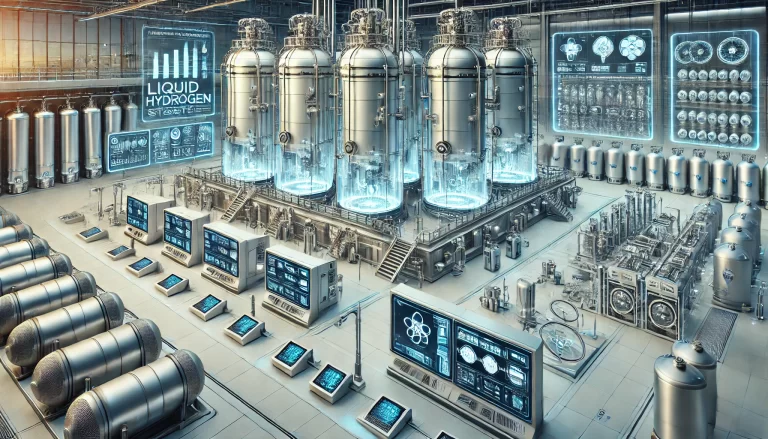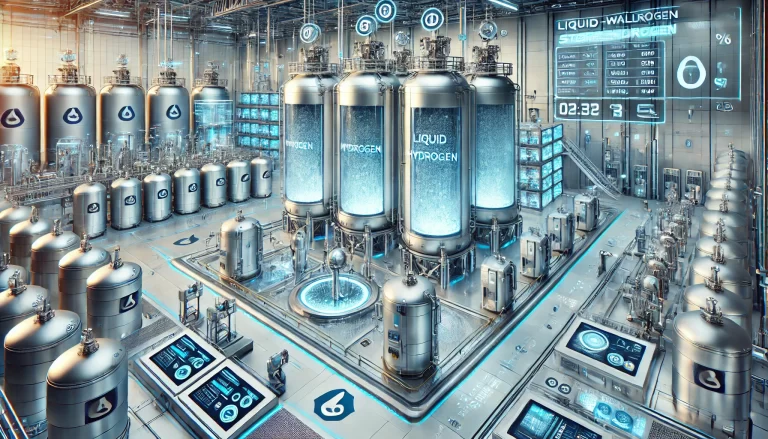Introduction
With the rapid development of hydrogen energy technologies, liquid hydrogen has emerged as a high-efficiency, clean energy source widely applied in energy storage, transportation, and industrial production. However, storing and distributing liquid hydrogen involves complex operations under low-temperature and low-pressure conditions. Its high propensity to vaporize at ambient temperature and pressure necessitates precise control of temperature, pressure, and safety throughout the storage and distribution processes.
Automated control technologies for liquid hydrogen storage and distribution systems play a critical role in ensuring safe and efficient supply. This article explores the principles and challenges of these technologies, with a forward-looking perspective on future advancements.
Overview of Liquid Hydrogen Storage Systems
A liquid hydrogen storage system primarily cools hydrogen gas to its liquid state and stores it at cryogenic temperatures and low pressures for extended periods. These systems typically feature double-walled storage tanks, where the outer layer provides insulation to reduce heat transfer, and the inner layer contains the liquid hydrogen. The storage temperature is maintained at approximately -253°C to prevent vaporization.
Key Challenges in Storage:
Thermal Control: Even minor temperature variations can lead to liquid hydrogen vaporization. High-efficiency insulation is essential to minimize heat ingress.
Pressure Regulation: Excessive pressure can cause leaks or explosions, while insufficient pressure may accelerate vaporization. Automated systems must maintain pressure within safe limits.
As a result, these systems integrate a suite of automated control equipment to monitor and regulate critical parameters such as temperature, pressure, and liquid levels in real-time.

Automated Control Technologies for Liquid Hydrogen Systems
1. Temperature and Pressure Monitoring and Control
The cryogenic conditions necessary for liquid hydrogen storage demand advanced temperature and pressure control technologies.
Temperature Control: High-precision temperature sensors, such as Resistance Temperature Detectors (RTDs) and thermocouples, are integrated with Programmable Logic Controllers (PLCs) to enable real-time temperature monitoring and adjustment. These sensors can detect minute changes in temperature, allowing the system to adjust refrigeration equipment dynamically and prevent premature vaporization or overcooling that could lead to excessive pressure.
Pressure Control: Pressure regulation involves real-time monitoring using pressure sensors. If the system detects pressure exceeding safe thresholds, safety relief devices or automated valves are activated to release excess pressure. Conversely, in low-pressure scenarios, backup systems ensure the injection of additional hydrogen gas to stabilize the pressure.
2. Liquid Level Monitoring and Control
Managing liquid levels within storage tanks is critical to avoid operational risks:
Monitoring Technology: Advanced sensors, such as radar or float-based level sensors, are commonly employed. Radar sensors are preferred for cryogenic environments due to their high stability and reliability compared to ultrasonic sensors.
Control Systems: Data from level sensors is analyzed to adjust hydrogen refilling rates. For instance, if levels approach the upper limit, the system reduces intake to prevent overflow. Conversely, low levels trigger alarms and initiate hydrogen replenishment.
3. Hydrogen Refueling and Distribution Automation
Liquid hydrogen refueling and distribution processes rely heavily on automated control to ensure safety and efficiency:
Refueling Systems: Gas compressors and precision valves regulate refueling speed, pressure, and temperature. Automated systems continuously analyze tank parameters such as temperature, pressure, and liquid level to optimize refueling operations.
Distribution Systems: Liquid hydrogen is delivered from storage tanks to end-use equipment such as hydrogen fueling stations or hydrogen-powered systems. Automated distribution employs temperature control valves and pressure regulators for precise hydrogen delivery. Systems often incorporate boosters to increase the pressure of low-pressure hydrogen before transfer.
4. Safety Monitoring and Alarms
Given hydrogen’s highly flammable nature, robust safety measures are indispensable. Automated systems include:
Leak Detection: State-of-the-art technologies, such as Tunable Diode Laser Absorption Spectroscopy (TDLAS), can detect hydrogen leaks at extremely low concentrations. These sensors outperform traditional methods in accuracy and response speed.
Emergency Response Systems: When anomalies such as leaks, overpressure, or temperature fluctuations are detected, the system initiates immediate safety measures. These include shutting off valves, triggering alarms, and adjusting operational parameters to mitigate risks.

Technical Challenges and Future Trends
Technical Challenges:
Cryogenic Storage: The ultra-low temperatures required for liquid hydrogen present challenges in insulation and temperature regulation. Innovations in advanced insulation materials and thermal management technologies are vital to reducing heat ingress and evaporation losses.
Safety and Leak Prevention: Hydrogen’s high flammability demands stringent safety measures. Emerging technologies, such as enhanced gas sensors and predictive maintenance algorithms, are essential to preemptively address risks.
Future Trends:
Intelligent Automation: With the integration of IoT (Internet of Things), real-time monitoring and data analytics will enable predictive maintenance, self-optimization, and fault detection. For instance, AI-driven systems can predict equipment failure based on historical data and automatically notify maintenance teams.
Advanced Materials: Development of lightweight, high-strength materials for storage tanks can further improve insulation and structural reliability.
Green Hydrogen Ecosystems: The growing adoption of renewable energy sources for hydrogen production emphasizes the need for sustainable storage and distribution solutions, with automated systems ensuring energy efficiency and minimal emissions.
Conclusion
Automated control technologies for liquid hydrogen storage and distribution systems are pivotal for the safe, stable, and efficient operation of hydrogen infrastructure. By integrating precise temperature and pressure controls, advanced level monitoring, and intelligent safety mechanisms, these systems reduce operational risks and enhance efficiency.
As technology evolves, the field is poised to benefit from greater integration of IoT and AI, driving further advancements in automation, safety, and sustainability. Liquid hydrogen’s role as a cornerstone of clean energy systems ensures that innovations in automated control technologies will continue to propel the hydrogen economy forward.
